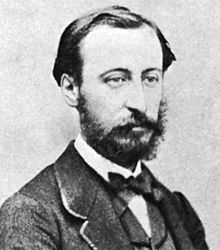2nd piano concerto (Saint-Saëns)
The 2nd Piano Concerto in G minor , Op. 22 , is a work for piano and orchestra by the French composer Camille Saint-Saëns .
Emergence
The occasion for the composition of the second piano concerto was a concert by the Russian pianist Anton Rubinstein . He planned to give a concert as a conductor in Paris in May 1868 and asked his friend Saint-Saëns to compose a work for it. The French composer then wrote the second piano concerto in just 17 days and played the piano part at the premiere on May 13th in Paris. Despite the short time it took to compose the work, it has a high compositional value and represents a high point in the composer's work. The work is dedicated to Madame A. de Villers.
To the music
occupation
Solo piano , 2 flutes , 2 oboes , 2 clarinets , 2 bassoons , 2 horns , 2 trumpets , timpani and strings
1st movement: Andante sostenuto
The main movement of this concerto reveals the sonata movement form in a fairly free treatment. The movement begins unusually with an extended and highly virtuoso piano solo cadenza . This already contains the main thematic material of the sentence. The orchestra then begins strikingly with a few tutti blows and opens the exposition . The enthusiastic main theme sounds in it, but at the same time it is always characterized by great unrest. Orchestra and piano interjections interrupt the thematic presentation again and again. Then the theme is expanded with new melodic ideas in a kind of repetition of the exposition in the same style. In performing the solo instrument developed brilliantly another basic ideas, the first falling from a passage scales and is supported by the timpani, builds to a virtuoso climax. On this the main theme reappears in a kind of recapitulation , magnificently performed by the whole orchestra with piano accompaniment. Now, at the correct place in the solo cadenza, there follows another extended piano solo passage, which, however, seems a little more restrained than the cadenza at the beginning of the movement. The coda is also still dominated by the solo piano. The theme of the beginning of the movement comes to life again and lets the movement fade away with a few tutti hits from the orchestra.
2nd movement: Allegro scherzando
Due to the andante tempo of the main movement, the second movement of this concerto is not a slower one, but a scherzo movement . The beginning of this scherzo flits past like a ghost and performed by the piano in the piano . A surprising change of time establishes a waltz theme initially performed by the violoncello . However, the Scherzo theme quickly prevails again, which is now presented in a minor modification. The action goes by ghostly for a while before a few soft chords to gentle bangs bring about a sudden end.
3rd movement: Presto
The finale is a virtuoso rondo . It begins with the stormy main theme of the solo piano presented in Forte , after an introductory motif that consists of a fast turning figure of the piano and remains an important component in the further course of the movement. The orchestra takes over the fast rotating figure before the piano in the piano repeats the main theme on woodwind chords. In the first couplet , the solo instrument with fast and pearly accompanying figures accompanies a slow theme in the orchestra, which basically only consists of a few sluggish chords. A tutti blow leads back to the main topic. In the simply constructed second couplet, the piano repeats a few pounding, almost violent chords, interrupted by virtuoso outbursts of their own. After this, the sentence has a stormy end, without the main theme being repeated.
effect
The first performance of the piano concerto on May 13, 1868 in Paris was a failure. Saint-Saëns, who had taken over the piano part, admitted that he had not had enough time to practice, since the concerto was composed in just 17 days. Among the audience in Paris, however, was Franz Liszt , who recognized the qualities of the work and encouraged Saint-Saëns to continue performing it. It soon grew in popularity. A few years later, Georges Bizet arranged the virtuoso work for piano solo in order to be able to perform it on solo evenings.
The second piano concerto is the most popular and most played piano concerto by Saint-Saëns today. It requires a high degree of virtuosity and precision from the pianist.
Web links
- Piano Concerto No.2, Op.22 (Saint-Saëns, Camille) : Sheet music and audio files in the International Music Score Library Project
- Summary of Saint-Saëns' piano concertos ( Memento from May 28, 2014 in the Internet Archive )
